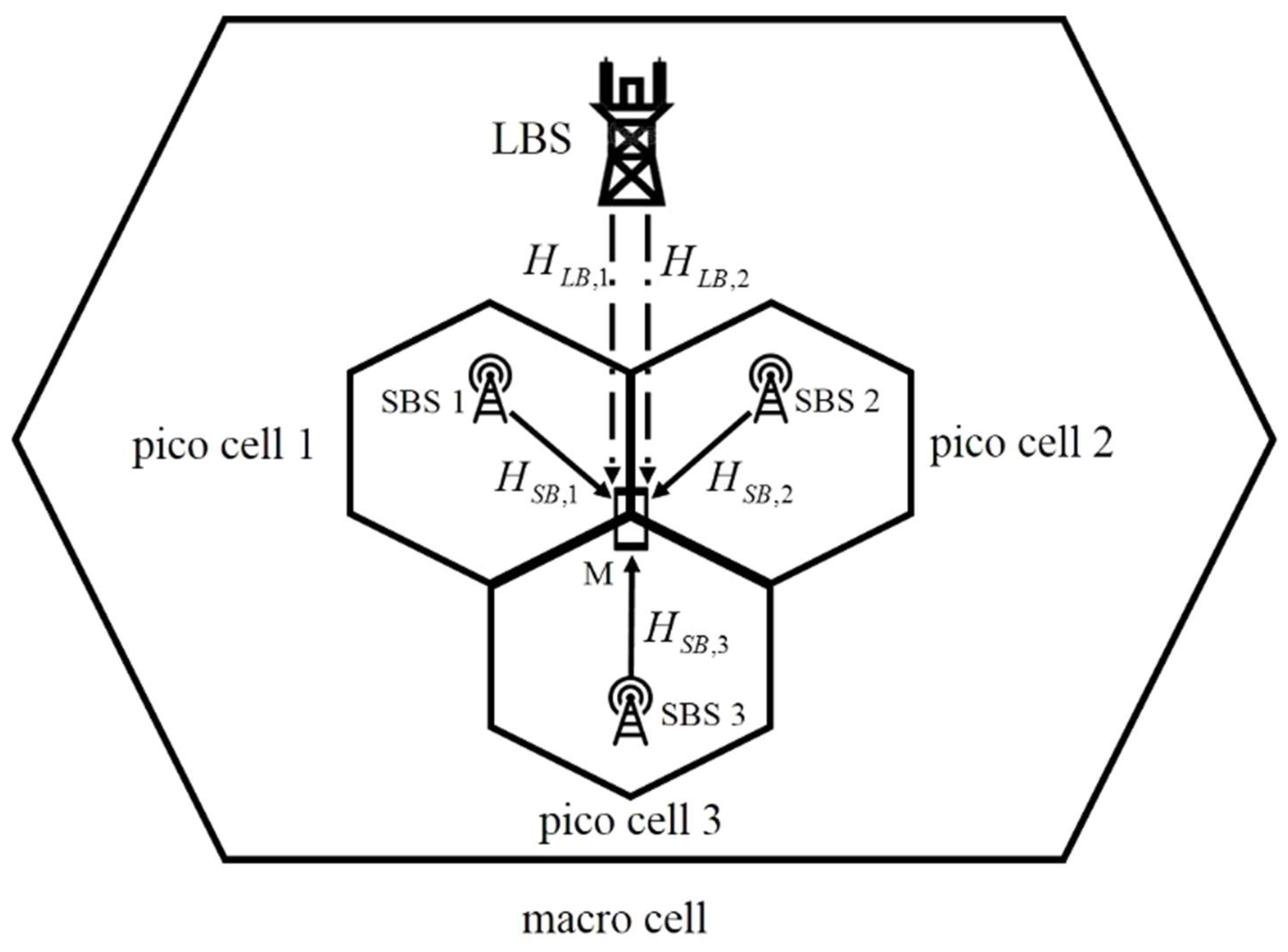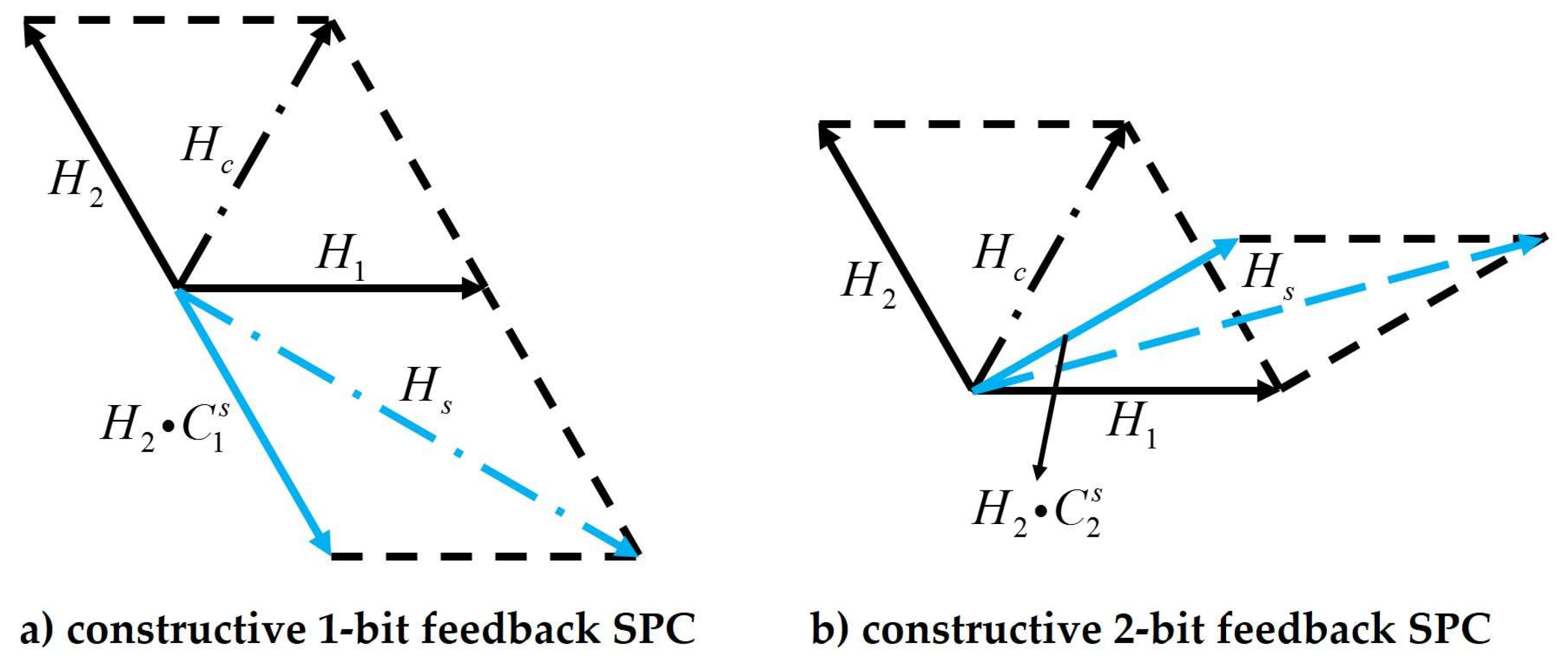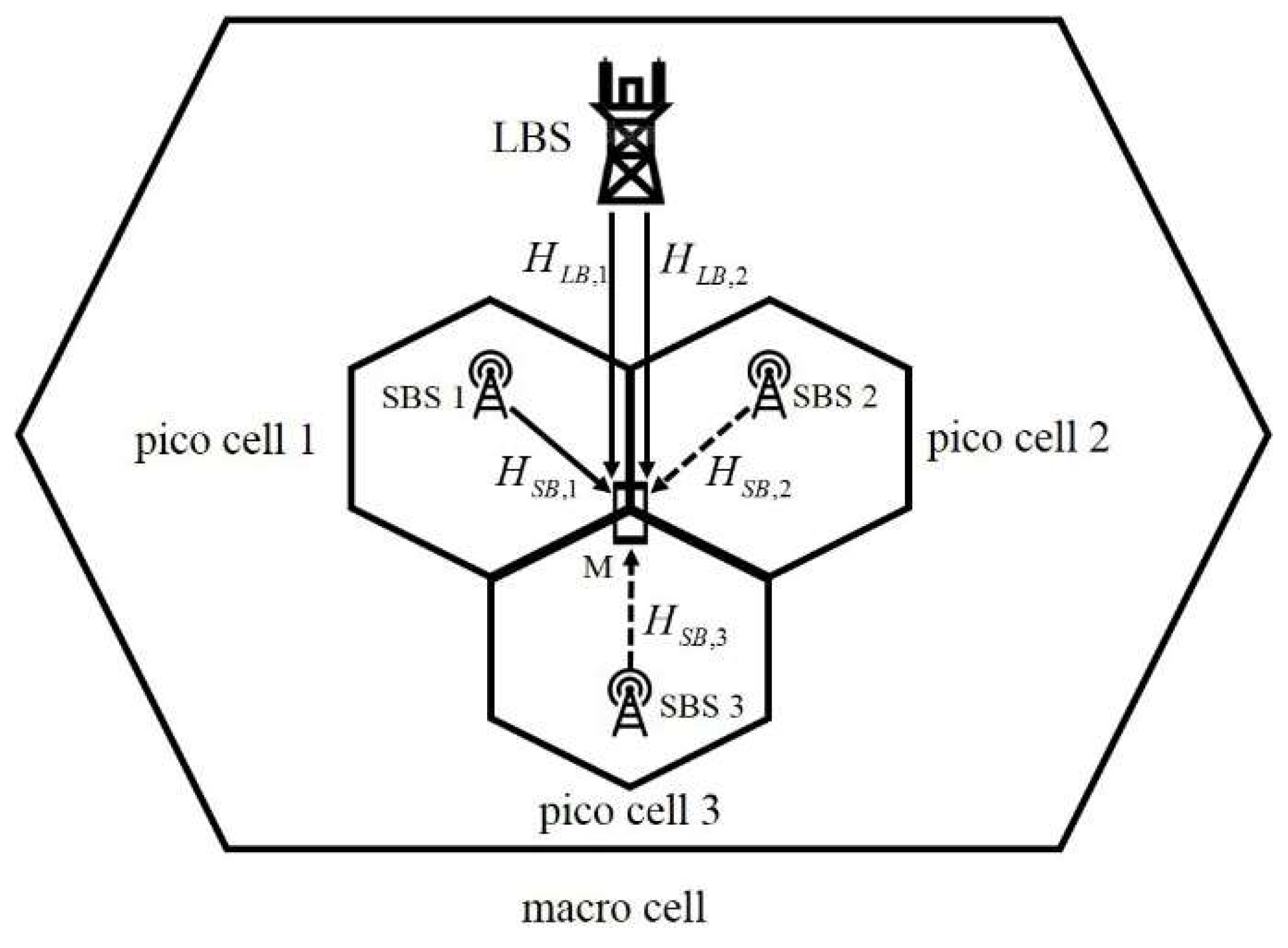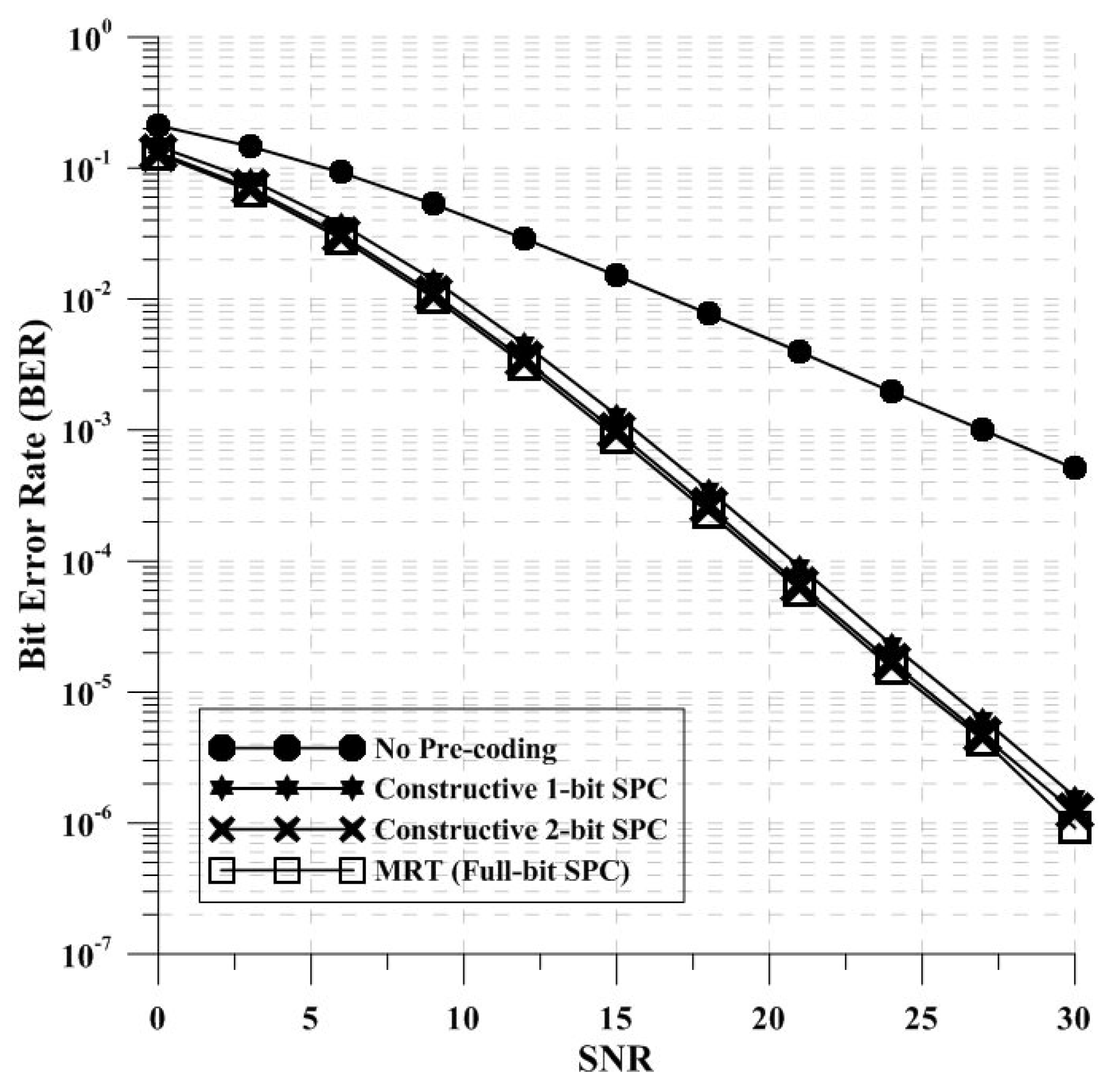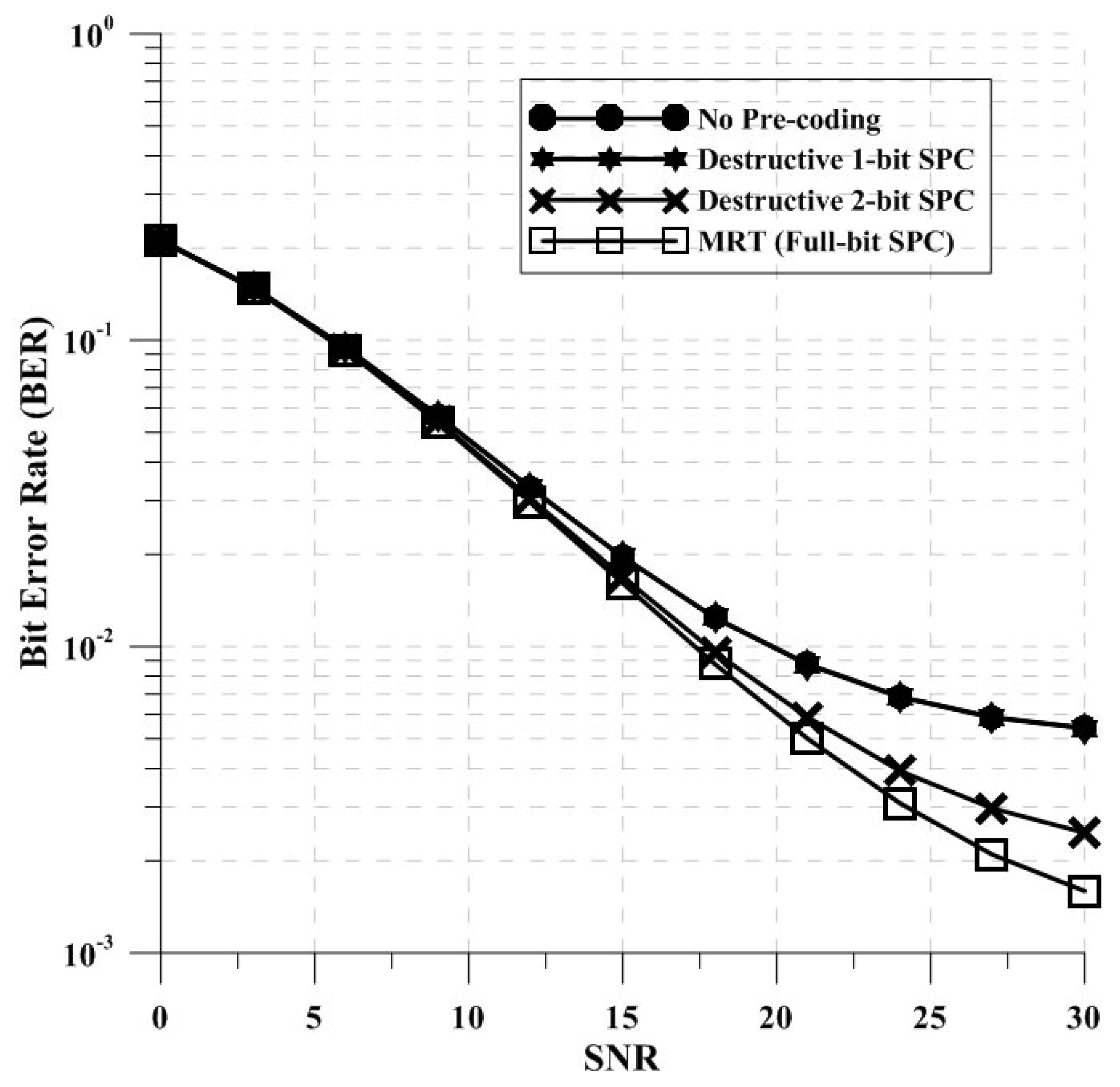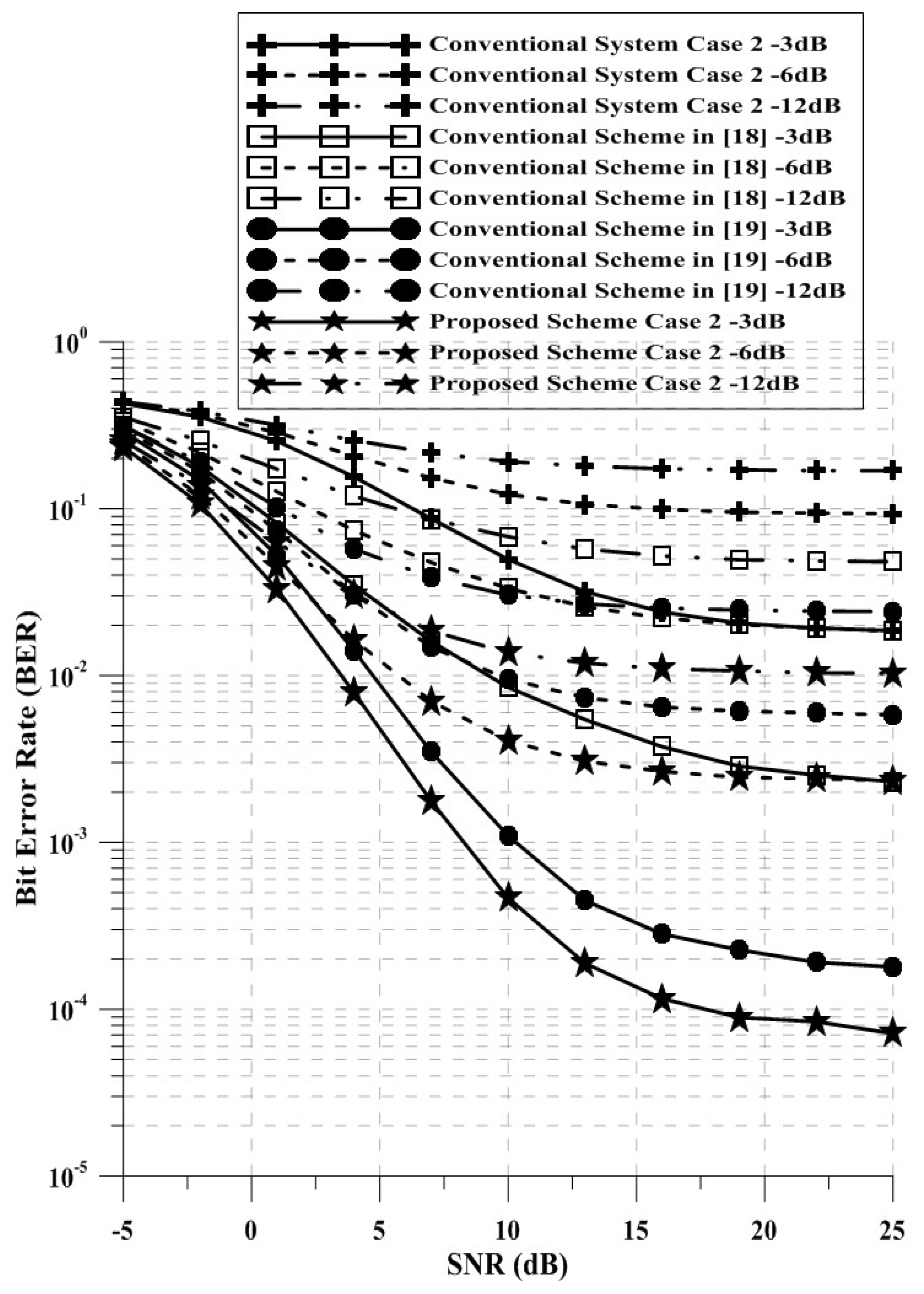1. Introduction
Nowadays, wireless communication systems require a high spectral efficiency and high reliability. The orthogonal frequency division multiplexing (OFDM) technique was developed, because it is one of the schemes which use frequency efficiently within a limited bandwidth [
1,
2,
3]. The OFDM technique is robust to the multi-path fading [
1]. Therefore, the OFDM technique has been widely applied to various wireless communication systems [
2,
3].
In the wireless communication systems, the amount of required traffic and data are increased. In order to satisfy needs, additional network nodes (or transmitting/receiving base station) must generally be built. The system in which the additional network nodes are constructed is the heterogeneous network (HetNet) system [
4,
5,
6]. By increasing the number of cells, the traffic per unit area can be increased without increasing the amount of traffic that must be supported per cell. The HetNet system is generally composed of a small cell, new access technologies, and various transmission power schemes of the base station. Also, arrangement of the small cell, such as the pico and femto cell, has advantage of expanding the capacity and cell coverage in the HetNet systems [
5]. There are many issues of research on the HetNet. The energy efficiency, analysis of cell coverage and interference mitigation are subjects of research on the HetNet. Trestian, et al. propose a mechanism that can save energy when multimedia data in HetNet small cell environment are transmitted [
7]. An algorithm for cell planning in HetNet to find the optimal number of cell sites subject to QoS requirements was proposed in [
8]. Dhillon, et al proposes a tractable heterogeneous cellular network model through the cell coverage analysis [
9]. In addition, a power allocation scheme for minimizing energy consumption in heterogeneous networks is proposed in [
10,
11]. In other words, the energy efficiency and cell coverage analysis are very important issues in HetNet system. Furthermore, the interference mitigation is a very important topic. Therefore, this paper focuses on interference mitigation.
However, the HetNet system can cause complex ICI scenarios, which are an important part of the HetNet system. In this paper, two representative scenarios are considered. The first scenario is the ICI by the signals transmitted from other mobiles in adjacent cell. When the mobile is located at the cell edge, the ICI occurs due to the signal transmitted from other mobiles to the other base station in the adjacent cell. The second scenario is the ICI by the signals transmitted from the base station in the adjacent cell. When the mobile is located in the cell edge, the ICI occurs due to the signal transmitted the base station of the adjacent cell to the other mobile. In the first scenario, because the interference signal is transmitted by the mobile in the adjacent cell, the power of the interference signal is lower than the interference signal transmitted by the base station. However, in the second scenario, because the interference signal is transmitted by the base station in the adjacent cell, the interference signal has high power. Therefore, it greatly affects the performance of the HetNet system. Owing to complex ICI scenarios, the reception performance of the mobile is reduced and consequently the reliability of the wireless communication system is reduced [
12,
13]. This paper proposes a scheme to mitigate the interference signal transmitted from the base station among the interference scenarios of the HetNet system.
In order to solve complicated ICI scenarios, this paper proposes a CoMP scheme in which the base station cooperates adaptively according to the location of the mobile. The CoMP scheme is a communication technique in which the base stations in adjacent cells cooperate with each other. In the proposed CoMP scheme, the mobile transmits feedback information (including the position, channel state information (CSI), etc.) to all base stations in adjacent cells. Then, the base stations apply the pre-coding scheme to the signals to be transmitted by using the received feedback information. As a result, the CoMP scheme proposed in this paper can improve the diversity gain of the mobile by using the signal with pre-coding scheme applying the feedback information [
14,
15,
16].
The pre-coding scheme used in the proposed CoMP scheme is SPC. The SPC scheme is one of the pre-coding schemes. The SPC changes the channel relationship between the base station and the mobiles by using the CSI [
17]. And then, the channel coefficients are increased by constructive superposition. In addition, the SPC changes the relationship of channels to destructive superposition. When a mobile user is located in the cell edge, the ICI is caused by the other signals transmitted from neighboring base station. If the mobile suffers from a transmitted signal from adjacent base station, the received signals have a large error and the performance degradation. But the interference signals can be suppressed through the destructive SPC scheme [
18,
19]. The schemes for interference mitigation using the relays are proposed in [
18,
19]. If a relay is used, an error propagation is present, and several pre-coding schemes must be performed to mitigate the interference. However, this paper proposes an interference mitigation scheme by performing only pre-coding without using the relay.
This paper is organized as follows.
Section 2 shows the system model of the proposed scheme.
Section 3 describes the constructive and destructive SPC principle.
Section 4 explains proposed scheme for the CoMP with pre-coding to improve the reliability of the HetNet system.
Section 5 shows the simulation results by comparing the conventional and the proposed scheme. Finally,
Section 6 presents our conclusion.
4. Proposed Scheme
In this section, the CoMP scheme using the SPC in base station is introduced for the HetNet system. In the CoMP scheme proposed in this paper, all base stations in the cells transmit signals by applying the constructive and destructive SPC adaptively according to the location of the mobile. There are three cases according to the location of the mobile. In case 1, location of the mobile is the center of the pico cell 1. In case 2, location of the mobile is between the pico cells 1 and 2. Finally, in case 3, the mobile is located among the three pico cells.
Figure 4,
Figure 5 and
Figure 6 show cases 1, 2 and 3 respectively.
Case 1:
Figure 4 shows case 1, in which the mobile is located in the center of the pico cell. In this case, the base station transmits the signal to the mobile through the conventional communications system. The base station transmits the signal to the mobile by using the single input single output (SISO) OFDM technique. The mobile receives one signal transmitted from the base station, as follows,
The is the channel coefficient between the base station of the pico cell 1 and the mobile, is the transmitted OFDM symbol, and is the AWGN.
Case 2:
Figure 5 shows case 2, in which that the mobile is located between the pico cells 1 2. When the mobile is located between the the two cells, it receives a signal which is distorted by the interference signal transmitted from the base station of the pico cell 2. The received signal is as follows,
is the signal transmitted from the base station of pico cell 2.
is the channel coefficient between the base station of the pico cell 2 and the mobile.
refers to the desired signal. Because
is not a desired signal, it is regarded as noise by the mobile. The Equation (9) describes a received signal when the mobile is located within the intersection of two pico cells. When the number of the pico cells is increased, the received signal is as follows,
In Equation (10), means the index of the pico cell and denotes the number of the pico cells.
In case 2, the proposed CoMP scheme forms the virtual MISO system in cooperation with the base station of the macro cell for improving diversity gain of the mobile and interference mitigation. One of the base station antennas of the macro cell transmits the signal using the constructive 2-bit feedback SPC scheme, in order to improve the diversity gain of the mobile by raising the SNR of the desired signal. Additionally, the other antenna transmits the signal with the destructive 2-bit feedback SPC scheme in order to mitigate the effects of interference by reducing the SNR of the interference signal. After the constructive and destructive SPC scheme are applied, the received signal is as follows,
In this case, the pre-coding vectors of
and
facilitate that the channel coefficient is either constructively and destructively superimposed, respectively.
can be larger than
and
can be smaller than
. Therefore, the SNR of the desired signal is increased, and the SNR of the interference signal is reduced. As such, the diversity gain of the mobile is improved and interference is mitigated. When the number of pico cells and base station antennas in the macro cell is increased, the received signal is as follows,
In Equation (12), the means the index of the base station antenna in the macro cell.
Case 3:
Figure 6 shows the case 3 that the mobile located within the intersection of three pico cells. When the mobile is located within the intersection of the three pico cells, the mobile receives the signal distorted by the interference signal transmitted from the base station of the pico cell 2 and pico cell 3. The received signal is as follows,
The
is the interference signal transmitted from the base station of pico cells 2 and 3.
is the channel coefficient between the base station of the pico cell 3 and the mobile.
denotes the desired signal. Because
is not a desired signal, it is regarded as noise by the mobile. When the number of the pico cells is increased, the received signal is as follows,
In case 3, the proposed CoMP scheme forms the virtual MISO system in cooperation with the base stations of the macro cell for improving diversity gain of the mobile. The base station of the macro cell transmits the signal with the constructive 2-bit feedback SPC scheme, in order to improve the diversity gain of the mobile by raising the SNR of the desired signal. Additionally, the base stations of pico cells 2 and 3 transmit the signal with the destructive 2-bit feedback SPC scheme in order to mitigate the effect of the interference, by reducing the SNR of the interference signal. After the constructive and destructive SPC scheme are applied, the received signal is as follows,
In this case, the pre-coding vectors
and
facilitate that the signal is constructively and destructively superimposed respectively.
can be larger than
and
can be smaller than
. Therefore, the SNR of the desired signal is increased, and the SNR of the interference signal is reduced. When the number of pico cells and base station antennas in the macro cell is increased, the received signal is as follows,
Also, the schemes in [
18,
19] mitigate the interference but exhibit several disadvantages. These schemes use the relay; as such, a complicated relay selection scheme is needed. Because the schemes apply the pre-coding not only to the base station but also to the relay, a large number of feedback bits are required. The schemes in [
18,
19] can mitigate the interference only when the channel conditions between the base station and relay are good. Additionally, the interference mitigation methods of [
18,
19] can reduce the transmission rate due to the use of the relay, but the interference mitigation scheme proposed in this paper cannot reduce the transmission rate. As a result, the proposed CoMP scheme can increase the diversity gain of the mobile, without reducing the transmission rate, and can efficiently mitigate interference.
The proposed CoMP scheme uses constructive and destructive SPC schemes adaptively, according to the location of the mobile. This CoMP scheme improves the diversity gain of the mobile by increasing the SNR of the desired signal through the constructive 2-bit feedback SPC scheme. Additionally, when the mobile is located in the cell edge and is affected by the interference, the effect of the interference is mitigated by reducing the SNR of the interference signal using the destructive 2-bit feedback SPC scheme. Therefore, the proposed CoMP scheme improves the reliability of the HetNet system by improving the reception performance of the mobile.
5. Simulation Results
In this section, 2-bit feedback SPC is compared to 1-bit feedback SPC. The proposed CoMP scheme is compared to the conventional scheme. The simulation results are based on the OFDM system. The simulation parameters are as follows: the number of carriers is 256 and the length of the cyclic prefix (CP) is 64. The modulation order is quadrature phase shift keying (QPSK). All channels are the Rayleigh fading channels of 7-multi paths. The conventional coding is applied with the code rate of 1/2 and constraint length of 3. The path loss is applied to the signal according to distance between the base station and mobile [
5].
Figure 7 shows the BER performance of the constructive SPC and MRT (full-bit SPC) scheme. The constructive 2-bit SPC scheme has higher BER performance than the constructive 1-bit SPC scheme in all SNR environments. In addition, the constructive 2-bit SPC scheme achieves a BER performance similar to that of the MRT scheme with only 2-bit feedback information. Therefore, the proposed CoMP scheme uses the constructive 2-bit SPC scheme to improve the diversity gain of the mobile and reduce implementation complexity.
Figure 8 shows the BER performance when the interference is mitigated by the destructive SPC and MRT (full-bit SPC) schemes. The destructive 2-bit SPC scheme mitigates interference better than the 1-bit destructive SPC scheme. And, the destructive 2-bit SPC scheme has lower performance than the MRT scheme. However, in the MRT scheme, the implementation complexity is high because all feedback information on the channel phase experienced by the interference signal is used. Therefore, the proposed CoMP scheme uses the destructive 2-bit SPC scheme to mitigate the interference signal.
Figure 9 shows the BER performance of the proposed and conventional schemes. In this figure, −3, −6 and −12 dB mean the power in proportion to ICI compared with the signal power. The conventional system refers to the system without interference mitigation, and the conventional scheme refers to the scheme proposed in [
18,
19]. When the mobile is located between two adjacent pico cells (case 2), the proposed and conventional schemes improve the diversity gain and mitigate the interference by applying the constructive and destructive SPC schemes. However, because the conventional schemes use a relay base station or relay mobile, system performance is reduced by propagating errors to the receiver. The proposed scheme does not use a relay base station or relay mobile and the pre-coding is applied directly in the base station in the pico cell, so there is no performance degradation due to error propagation.
In case of the conventional system case 2, the BER
is not satisfied in all SNR environments regardless of the ratio of interference signal to the desired signal. In the conventional scheme in [
18], when the interference signal has the lowest power, it satisfies BER
at approximately SNR 9 dB. However, the remaining case of the conventional scheme in [
19] does not satisfy the BER performance in all SNR environments. On the other hand, the proposed scheme satisfies BER
at approximately 3, 7 and 18 dBs. Therefore, the proposed scheme has better BER performance than the conventional schemes.
Figure 10 shows the BER performance when there are no interference signals (case 1) and the mobile is located between three pico cells (case 3). In case 1, because there are no interference signals, the proposed scheme has the same BER performance as that of conventional systems. In case 3, because the interference signal is transmitted from the other two base stations, the conventional scheme has low BER performance. The proposed scheme applies both constructive and destructive SPC schemes, to improve the diversity gain of the mobile, and to mitigate interference signals. Case 2 in the conventional scheme does not satisfy the BER
in all SNR environments. On the other hand, the proposed scheme increases the SNR of the desired signal and mitigates the interference through pre-coding scheme. So, the proposed scheme satisfies high BER performance in a low SNR environment. As a result, the proposed scheme can improve the performance and reliability of the HetNet systems by effectively mitigating interference signals even if the mobile is located between three adjacent pico cells.
As shown in the simulation results, the proposed scheme has higher BER performance than the conventional scheme. The proposed scheme can effectively mitigate the interference by using the pre-coding in the HetNet system without the relay base station or relay mobile. As a result, the proposed scheme can improve the performance and reliability of the HetNet system.
6. Conclusions
This paper proposes the CoMP scheme with the pre-coding scheme in order to improve reliability and mitigate the interference in the HetNet system based on OFDM. The proposed CoMP scheme improves diversity gain, and mitigates the interference signal by adaptively using the constructive and destructive SPC scheme according to the mobile’s location. Therefore, the SNR of the desired signal is increased, and the SNR of the interference signal is reduced, thereby the reception performance of the mobile is improved. In addition, because the proposed CoMP scheme does not use a relay, interference can be mitigated without additional transmission rate reduction, security problems, or error propagations. However, in order to mitigate interference, the proposed scheme requires pre-coding vectors according to the channel relationship between mobile and base station.
Several topics serve as background research for the HetNet system. Such research includes energy efficiency and optimization issues. Energy-efficiency for real-time vehicular cloud services, allocation of virtual elements (VEs) for minimizing the energy consumption and routing algorithm for energy-limited heterogeneous fog-supported wireless sensor networks are proposed in [
21,
22,
23] respectively. The analysis of robust optimization under multi-band uncertainty is included in [
24]. In addition, [
25] proposes a hybrid system based on genetic neural computing (GNC). Because the GNC is a hot topic, it can be considered as a research issue of the HetNet system. Therefore, we plan to study more efficient interference mitigation schemes through the joint transmission (JT) scheme—which is one of the CoMP types—, beamforming scheme, and power allocation for energy efficiency. The simulation results show that the BER performance of the proposed scheme is better than that of conventional schemes. As a result, the proposed CoMP scheme can improve the reliability of the HetNet system.
